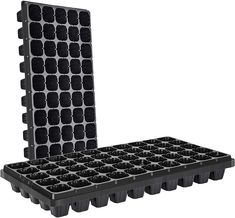
A seedling tray is a container used to sow multiple seeds at once. After seed germination, seedlings grow in the seed tray until they are large enough for transplant. A single seed tray can hold anywhere from 6 seeds to over 1000 seeds.
Parts Of A Seed Tray
There are two basic parts to a seed tray, one of which is optional:
- Tray – this is the outer part that holds soil, individual containers (pots), or a cell flat. When used with a cell flat, the tray is used for watering from below.
- Cell flat (plug flat) – this is the optional inner part. You can put a cell flat inside of a tray to separate seeds from one another.
Seedling trays can come in different forms;
- Mesh seed tray – a mesh seed tray allows water to drain out easily. A mesh seed tray is best for holding multiple individual containers (pots). A drawback is that the holes in a mesh seed tray are too large to hold soil without it falling through or washing away when watered.
- Solid seed tray with drainage holes – a solid seed tray with drainage holes allows for adequate drainage, but allows soil to stay moist enough for seed germination. A solid seed tray with drainage holes is best for planting multiple seeds together in one place. A drawback is that the seedlings do not have individual cells, so their roots can get tangled together as they grow.
- Solid seed tray without drainage holes (leak proof seed tray) – a solid seed tray without drainage holes does not allow for any drainage. A solid seed tray without drainage holes is best for holding a cell flat. Since it holds water, it can be used to catch excess water from watering seeds, or it can be used to water from below.
A cell flat (or plug flat) is a container that is divided into multiple cells. Some common cell counts for seed trays are:
- 50 cell seed tray
- 72 cell seed tray
- 128 cell seed tray
- 200 cell seed tray
- 288 cell seed tray
50 cell seed tray
These trays are a happy medium of saving you space in your seed starting area while still being able to plant a large number of seedlings like lettuce that will be directly transplanted. Because the 50 cell tray has a much larger soil volume than the 72 cell plug trays or 128 cell trays, you will have a bit more wiggle room when you need to transplant for optimal root growth. Plants grown in these trays will be less likely to become root-bound if unsettled weather delays your planting. This size also allows for canopy development of the seedling.
72 cell seed tray
The 72 cell seed tray are the most popular choice amongst market gardeners. They are a good balance between space for growing and seedlings per tray. Each cell is 1.5″ square and 2.25″ deep, making them an excellent option for a large variety of plants. These plastic trays are also a good choice for vine plants. However, you will want to transplant the vine plants earlier than you would with the 32 Cell trays to prevent root bound seedlings.
128 cell seed tray
These 128 Cell Trays are a great choice if you wish to start row crops or many baby greens. This configuration is ideal for starting many seeds but is not meant for crops that need more than a few weeks. Each cell is 1″ square and 2.25″ deep. You will be able to plant 78% more seedlings with one tray than the more common 72 cell seed starter trays. These 128 seed trays are compatible with the heavy-duty 1020 deep tray for bottom watering. You will want to up-pot your seedlings from this size seed tray into a larger pot or grow bag if you do not plan to transplant outdoors for an extended period to prevent seedlings from becoming root-bound.
200 cell seed tray
These 200 Cell Trays are excellent trays if you want to be economical about growing cole crops, lettuces, and other small-seeded crops. You will be able to grow 2.8 times as many plants with one tray as you would with a 72 cell tray. Each cell is 0.75″ square and 2.25″ deep.
If you are using 200 cell plastic trays to start seeds, you will need to transplant your seedlings at an earlier stage. Typically once they have one, at most two sets of true leaves. This plastic tray size is most frequently used by larger-scale farmers and those who intend to pot up their seedlings multiple times before moving outside.
Factors to consider before using seedling trays
- Specification of seedling tray
The common seedling tray size is 540mm x 280mm with different cells. The less the number, the larger the cell. The numbers of cells are 50, 72, 105, 128, 200, etc. The selection of plug tray specifications should not only consider the size and shape of the seeds, but also the size of the young plant. Only by selecting the proper size can the seedlings achieve optimal growth.
- Hole shape of seedling tray
There are two shapes of holes in seedling trays: round and square. The round hole has a smooth inner wall, without corners of the square hole, which is conductive to the winding of the root of the plant on the inner wall. The square hole is good for guiding the roots to extend downward, and the substrate capacity is about 30% more than the round one. The water is distributed evenly and the roots can grow better.
- Thickness of seedling tray
The thickness of the common seed trays on the market is 0.6 to 1.2 mm. 0.6-0.8 thickness plug trays are mostly used for manual sowing or one-time use, for example, if selling the young plants with seed trays, the seedling company can choose 0.6-0.8mm thickness trays. 1.0~1.2 mm thickness trays are suitable for machine sewing and reuse after disinfection.
- Depth of seedling tray
The depth of the seed tray on the market is 3-5 cm, the deeper the tray depth, the larger substrate quantity and the greater the substrate water retention, then the more conductive to roof growth. There are also special-purpose seedling trays with a depth up to 9-11 cm.
- Suitable trays for vegetable and fruit seedlings
Generally, a 50 cell tray is fixed for fruit plant seedlings, such as cucumbers, melon, watermelons, pumpkins, etc. The 72 cells one seedling tray is mostly for vegetable propagation, such as eggplant, tomatoes, etc.
105 cells and 128 cells are mostly for leafy vegetable propagation, such as lettuce, cabbage, kale, spinach, cabbage, broccoli, etc.
- Material of seedling tray
At present, the seed trays used for seedling cultivation mainly include plastic seed trays and polystyrene foam trays. The main materials of the plastic plug are polystyrene (PS), polyvinyl chloride (PVC) and polypropylene (PP). The polystyrene is resistant to high temperature, not easy to deform in summer, has good toughness, and does not break easily in harsh climates.
Benefits of using seedling trays
There are many advantages to using a nursery tray as opposed to other solutions, like growing in larger containers. It is incredibly simple to handle, sow, and plant seeds, and it also makes transplanting easier as seedlings grow. If you want to improve your chances of growing healthy plants and make sure they have enough room to grow and thrive as they should be anticipated to do when they become fully grown plants in only a few months or years from now, it’s crucial to utilize nursery trays. The benefit of employing a nursery tray is that seeds can be sown indoors under the safety and supervision of a grower. Here are some of its benefits:
- Grow a variety of plants
- Improve Germination success rate
- Fertilize easily
- Excellent water drainage
- Effectively manage the temperature
- Transferring plants to larger containers is simple.
- Boosts productivity
- Saving money
Mazero Agrifood ltd has a variety of quality seedling trays that are of high quality and cost effective. Contact us today on +254729777711 to order.


Good